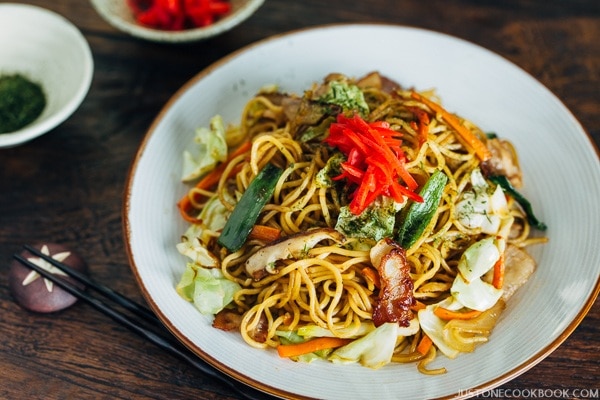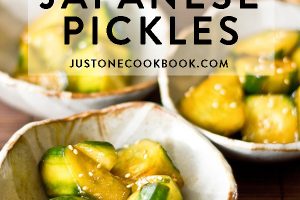Crunchy with an appetizingly sour & sweet-tart flavor, tsukemono are the Japanese pickles served alongside rice and miso soup. Find out more about the different types of tsukemono you may encounter in a Japanese meal.
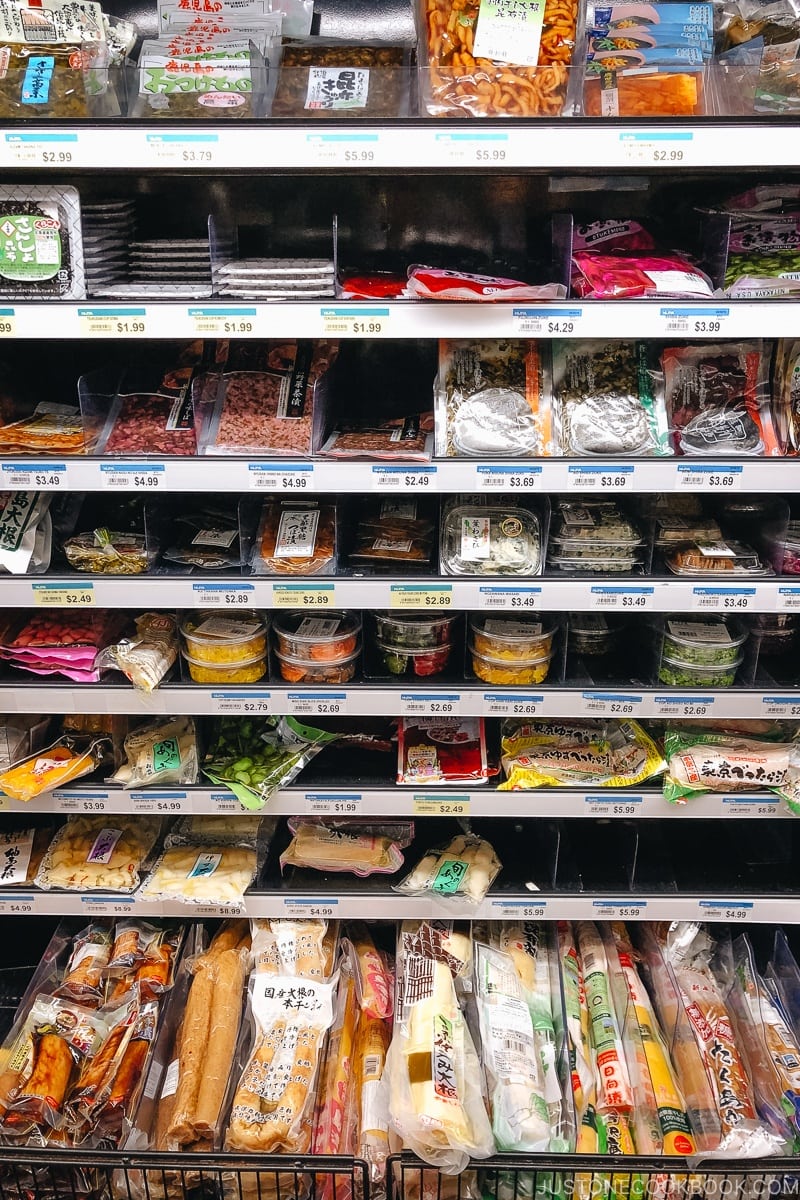
Tsukemono (漬物), or Japanese pickles, are preserved vegetables pickled in salt, salt brine, or rice bran. They come in varieties and forms, and you can often find one or two varieties of tsukemono being served in an Ichiju Sansai 一汁三菜 meal or as an accompaniment to sushi or as a garnish to a yoshoku (Japanese-western cuisine) dish like Japanese curry.
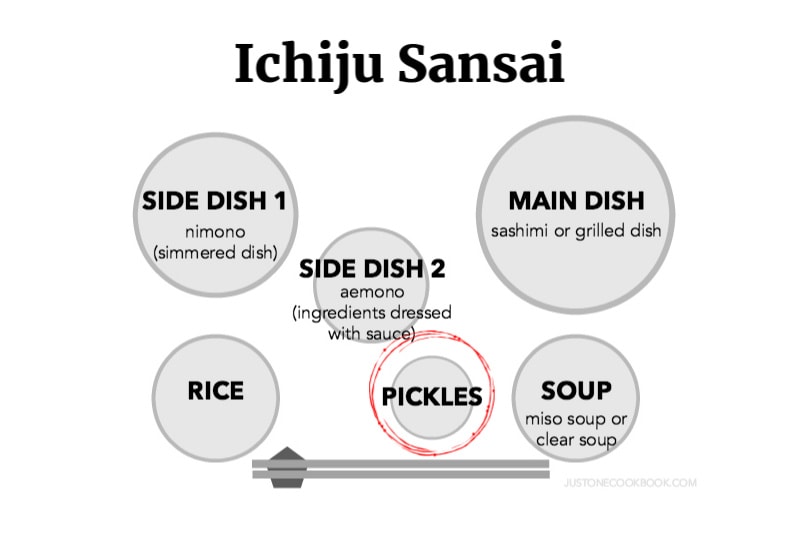
What Is Tsukemono
Tsukemono refers to Japanese pickles, which translates to “pickled things.” These pickles come in various styles, flavors, and colors and are often served as side dishes or accompaniments to meals in Japanese cuisine. The Japanese eat them with plain rice, mix it into onigiri rice balls, or pack it in their bento boxes.
The ingredients used for tsukemono can include a wide range of vegetables such as cucumbers, radishes, turnips, carrots, ginger, lotus root, and eggplant. The pickling process involves salting, brining, or fermenting, which can impart unique flavors and textures to the vegetables. It may also include herbs and spices, such as yuzu peel, kombu kelp, or red chili peppers for aroma and flavor.
Some are quick-pickled and ready to eat shortly after preparation, while others may undergo a fermentation process that takes more time.
The Role of Tsukemono in Ichiju Sansai
Sometimes, it can be easy to overlook the roles of these pickles, especially if you’re unfamiliar with Japanese food culture. Nevertheless, tsukemono is small yet mighty when it comes to its attributions. They are an essential player in Japanese cuisine, lending a range of colors, textures, and flavors to balance the main meal and render harmony. These pickles refresh the palate and provide refreshment to counter the heaviness of rich foods. They are called konomono (Kou no mono, 香の物) or “fragrant things.” Another quality they’re also known for is its many nutrients, such as vitamins, antioxidants, and probiotics that benefit digestive health.
While the realm of tsukemono is almost inexhaustible – with homestyle versions to regional and local specialties, here’s what you can commonly find in many well-known Japanese dishes. Are you interested in trying the pickles or making them at home? Take a trip to your local Japanese grocery store, and you’ll most likely find the popular ones there.
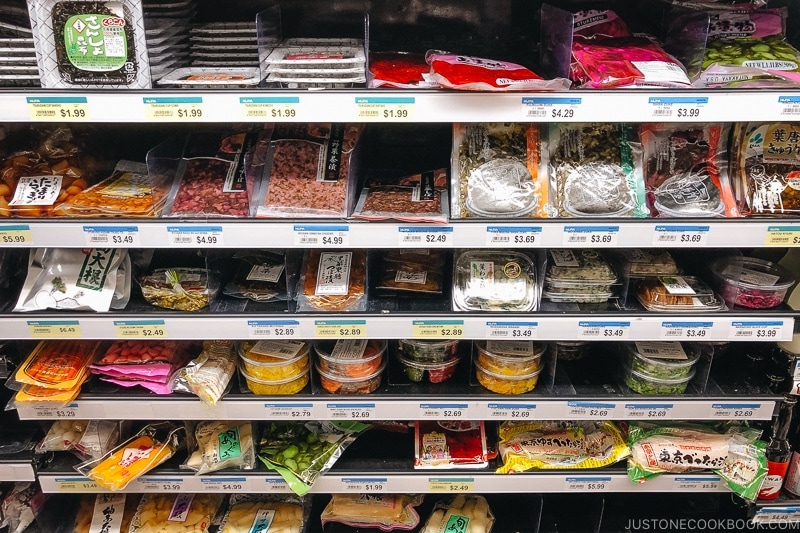

Most Popular Types of Tsukemono
Below are the popular tsukemono commonly paired with rice or served in an Ichiju Sansai setting:
1. Umeboshi 梅干し
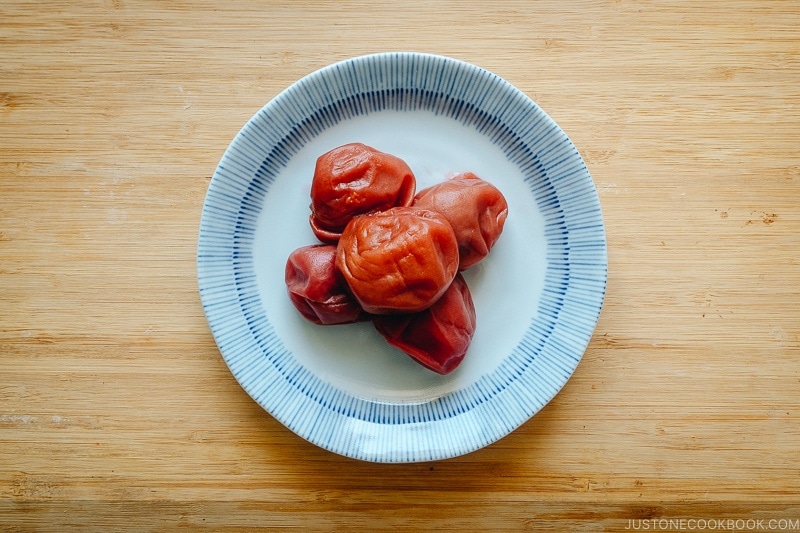
Umeboshi are pickled Japanese plums or ume (梅). Round, wrinkled with a characteristically dark pink or beige, they are made by drying, then pickling in salt under a weight. Traditionally, umeboshi are packed in salt with purple shiso leaves, which dye them a dark pinkish purple. They have a distinctive sour and sweet flavor and can be exceptionally salty. There are honey-packed umeboshi and low-sodium versions for those who prefer sweeter and less sour umeboshi.
You may have seen pictures of Japanese lunch boxes with an umeboshi in the center of the rice, which is called Hinomaru Bento (日の丸弁当) – the reddish umeboshi resembling the Japanese flag. The sour plums can also be found in onigiri, usually with their seeds removed for easy eating.
Recipe:
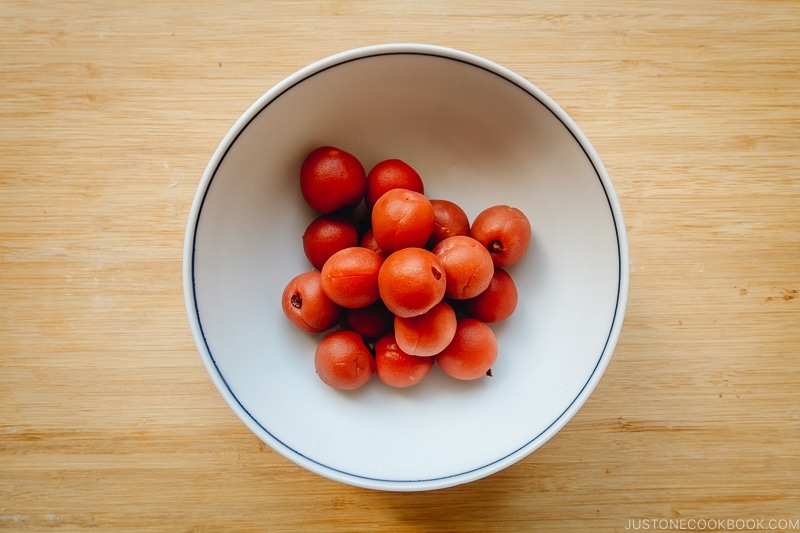
Koume 小梅
Another version you can find is koume. Koume (小梅), or “little plums,” are green unripe plums much smaller than umeboshi and undergo a similar preparation of salt packing. They are crunchy, unlike umeboshi.
2. Daikon Pickles – Takuan 沢庵
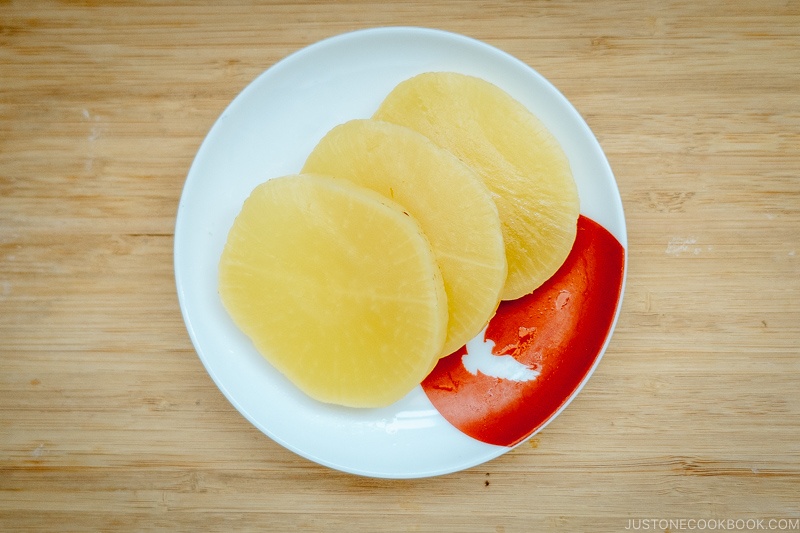
Bright yellow, Takuan is daikon that undergoes drying and then pickling in rice bran (米糠). Traditionally, the yellow hue is from the dried gardenia fruit (クチナシ) that’s in the pickling mixture. However, these days, commercial Takuan is artificially colored. It has a crunchy texture.
Also known as Danmuji in Korean, it is also enjoyed in Korean cuisine.
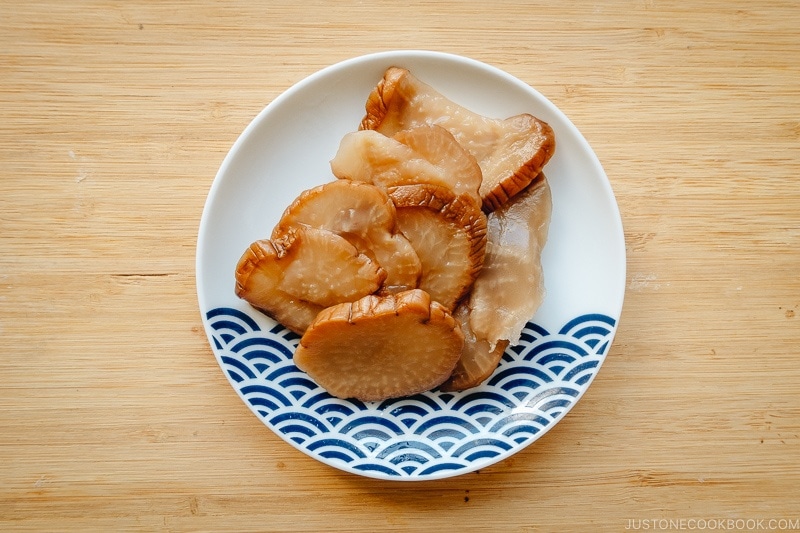
Iburigakko いぶりがっこ
Iburigakko is a regional type of Takuan from Akita prefecture in northern Japan, where the daikon is smoked instead of dried. Greyish yellow, it’s more crunchy than Takuan with a distinctive smoky aftertaste.
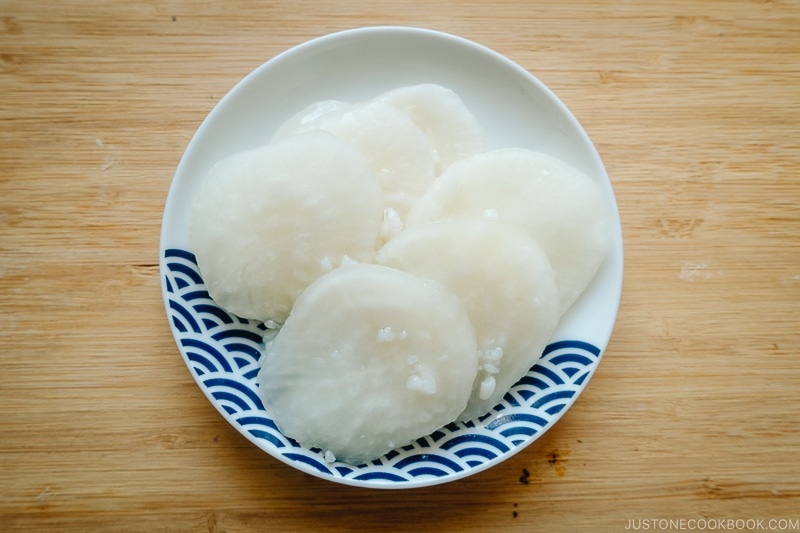
Bettara Zuke べったら漬け
Bettara Zuke are sweet daikon pickles hailing from Tokyo, packed with salt, sugar, rice, and rice koji. It has a sweet flavor.
3. Shibazuke 柴漬け
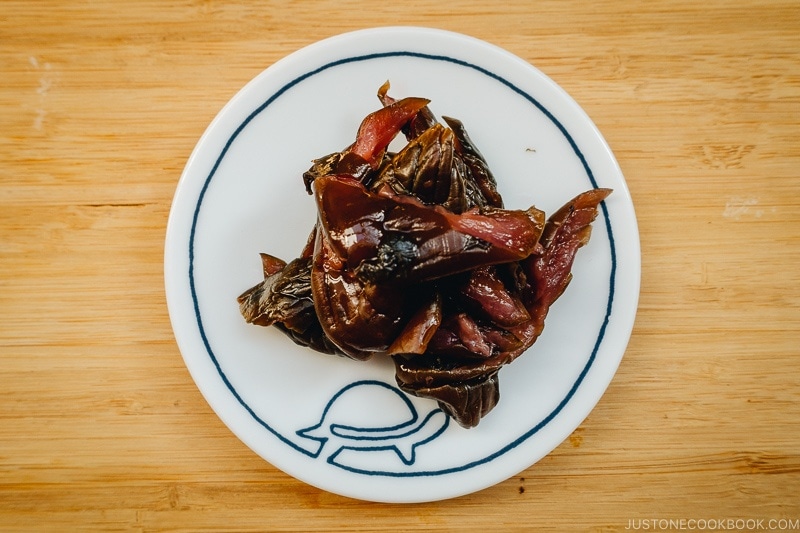
Shibazuke hails from Kyoto and is a variety of summer vegetables such as eggplant, cucumbers, myoga, and shiso leaves pickled together in umezu (Japanese plum vinegar). It is a common feature in Kyoto cuisine, but due to its popularity, they are enjoyed throughout Japan. One of the favorite ways of enjoying this pickle is with Ochazuke – steamed rice with tea poured over the rice.
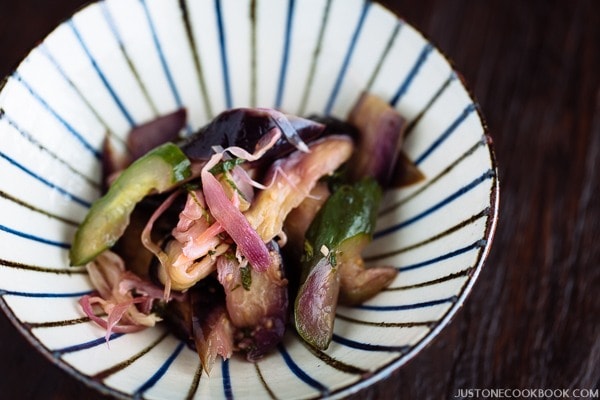
Recipe
4. Asazuke 浅漬け
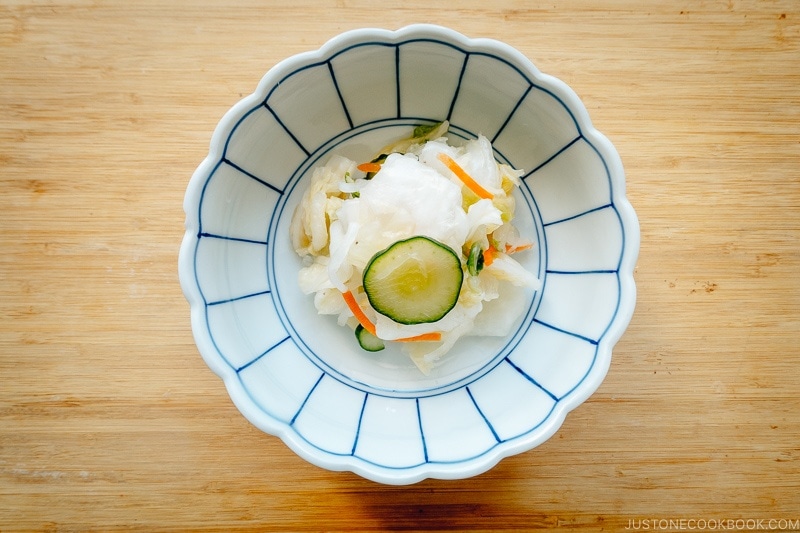
Asazuke refers to both the pickles and the pickling method. Literally “shallow-pickling,” the vegetables are pickled quickly (usually in the refrigerator) to preserve the crunchy texture. They are a favorite of home cooks as they are quick, easy, and don’t require any equipment. The most common vegetables used for Asazuke are daikon, Napa cabbage, cucumbers, and eggplant.
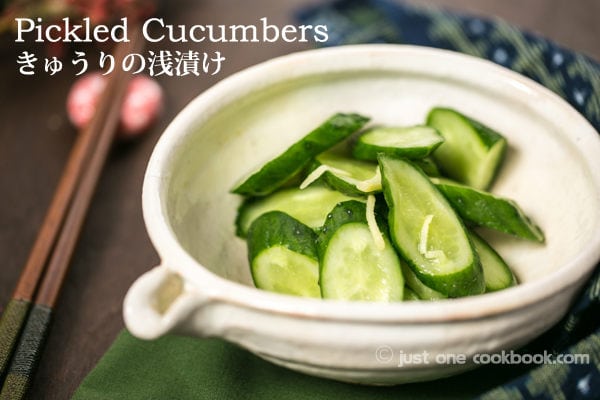
Recipes
You can make Asazuke by using a premade liquid solution called Asazuke no Moto (浅漬けの素) or follow the recipes below by using salt with the recipes below:
5. Nukazuke 糠漬け
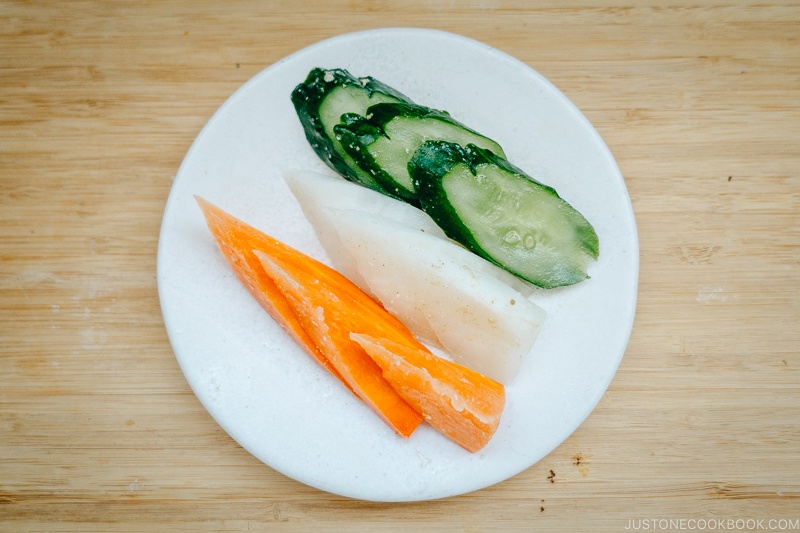
Nukazuke also refers to both the pickles and the pickling method. The vegetables are preserved in a brown spicy mash of roasted rice bran (Nuka 糠), salt, and kombu, which must be turned by hand daily. The pickling can last several hours to several months, resulting in a crispy, salty, and slightly yeasty pickle. Nukazuke are rich in lactobacillus and are said to benefit intestinal flora.

Popular vegetables for nukazuke are daikon (Takuan たくあん), carrots, cucumbers, cabbage, and turnips. However, some people have pickled sliced avocados, cherry tomatoes, and persimmons.
Other Types of Tsukemono
Beyond rice and Ichiju Sansai setting, you can find tsukemono being served in another style of Japanese dishes. Here are a few that you may have seen in different contexts:
6. Fukujinzuke 福神漬け
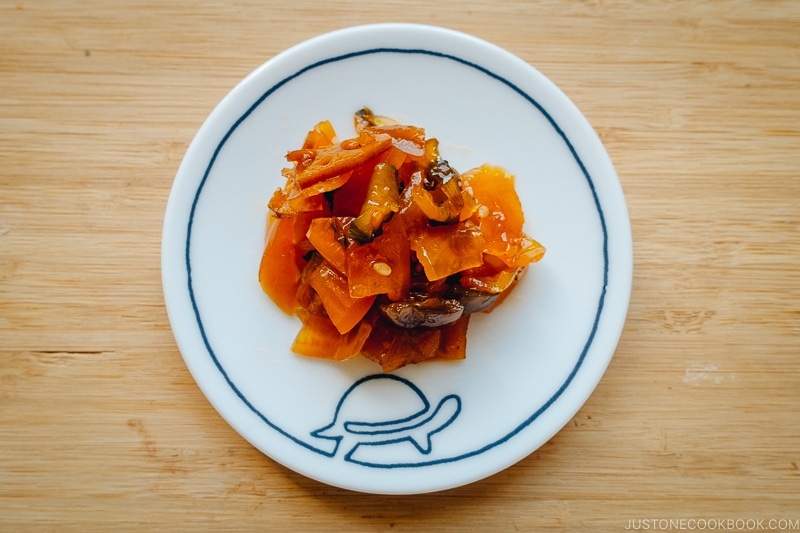
Not quite in the Tsukemono category, despite its name Zuke (漬け = to pickle), Fukujinzuke is lightly brined in a sweet soy sauce and does not undergo fermentation. The crunchy condiment is like a chunky chutney served with Japanese curry. It features seven vegetables, its name inspired by the Seven Lucky Gods (七福神).
Recipe:
7. Rakkyo らっきょう
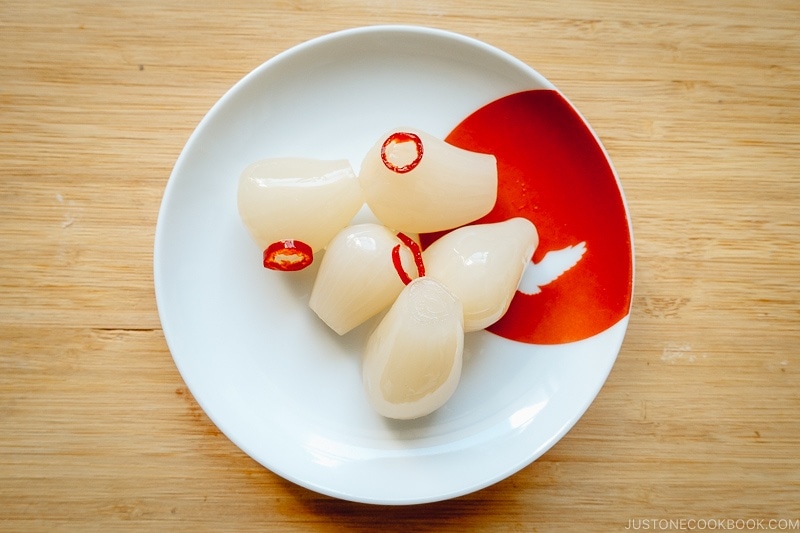
A pickle of the bulb of Chinese onions, Rakkyo can be pickled in salt, soy sauce, or sweet vinegar. It resembles a garlic clove but has a taste similar to shallots. You can also find it served alongside Japanese curry.
8. Ginger Pickles/Shinshoga 新生姜
Ginger pickles come in various forms and served in different settings. You are probably familiar with it as a palate cleanser eaten with sushi.
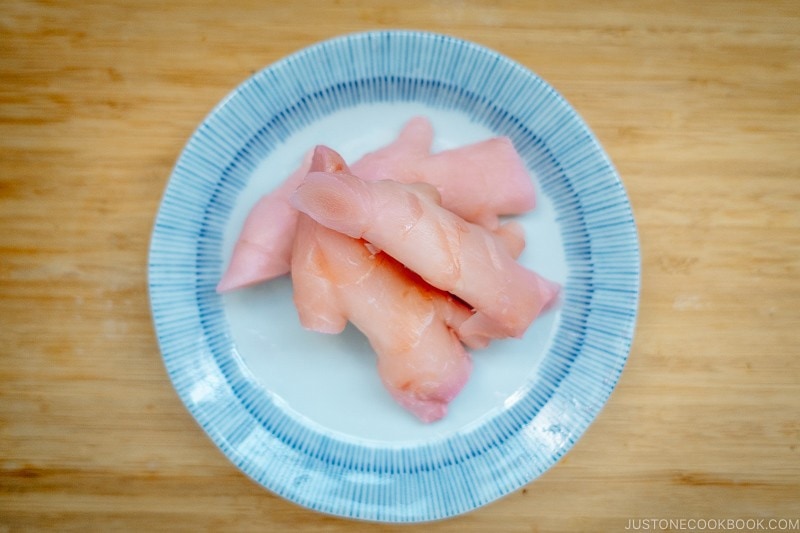
Shinshoga is young pickled ginger that is soaked in a sweet vinegar brine. It can have a blush pink color when made from young ginger, or artificially colored pink or beige if made from regular ginger.
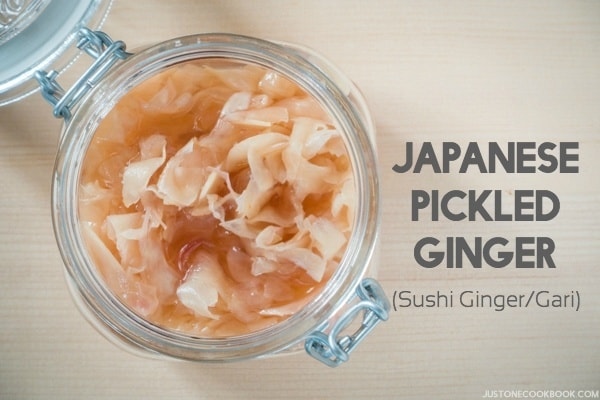
Gari ガリ
Thinly sliced Shinshoga, called Gari (ガリ), is a sushi accompaniment. The spicy and sweet-tart palate cleanser removes the fishy aftertaste, hence its presence with sushi. The name “Gari” is said to be from the onomatopoeia of the crunching noise or the sound of a knife thinly slicing it.
Recipe
Beni Shoga 紅生姜
The ruby red julienned pickles on top of Gyudon, Takoyaki, and Yakisoba are Beni Shoga. Like Gari, Beni Shoga has a darker pink shade due to its brine in Umezu (梅酢). Its tart and crunchy texture goes well with meaty or oily dishes and adds a pop of color. While usually a condiment to dishes, it can also be battered and deep-fried as tempura.

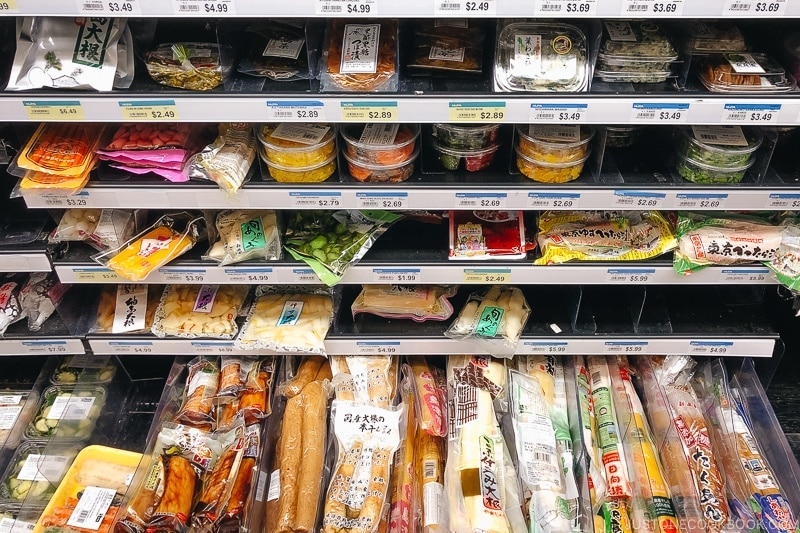
Preserving Tsukemono
Like any ancient preservation method seen worldwide, Tsukemono has been a way for Japanese people to consume nutrients and sodium when food is scarce. With the traditional and laborious methods becoming rare, finding quality mass-produced tsukemono at the grocery stores can be challenging. Regrettably, most store brands are made with artificial starters and other additives for quick fermentation.
We can still preserve the ancient art of lacto-fermentation by making tsukemono from scratch at home. Be it a quick pickling or a more elaborate fermentation, it’d be a worthwhile project to embark on!
For more Tsukemono recipes:
- Amazuzuke 甘酢漬け
- Kasuzuke 粕漬け
- Shoyuzuke 醤油漬け
- Misozuke 味噌漬け
- Shiozuke 塩漬け
- Pickled Watermelon Rind スイカの漬物
- Japanese Pickled Cucumber on a Stick


